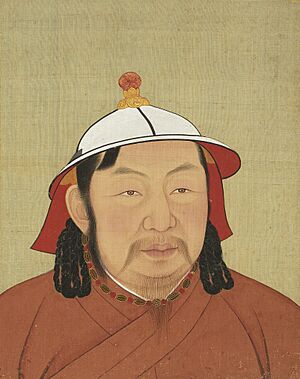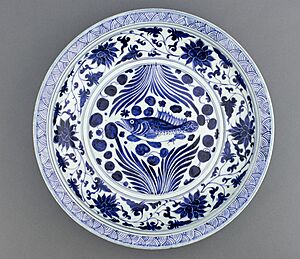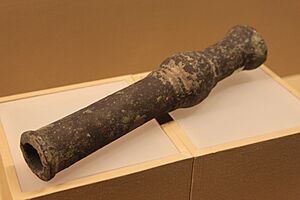Ayurbarwada Buyantu Khan facts for kids
Quick facts for kids Emperor Renzong of Yuan元仁宗 Buyantu Khan 普顏篤汗 ᠪᠣᠶᠠᠨᠲᠦ ᠬᠠᠭᠠᠨ |
|||||||||||||||||||||
|---|---|---|---|---|---|---|---|---|---|---|---|---|---|---|---|---|---|---|---|---|---|
| 8th Khagan of the Mongol Empire (Nominal due to the empire's division) Emperor of China (4th Emperor of the Yuan dynasty) |
|||||||||||||||||||||

Portrait of Buyantu Khan (Emperor Renzong) during the Yuan era.
|
|||||||||||||||||||||
| Emperor of the Yuan dynasty | |||||||||||||||||||||
| Reign | April 7, 1311 – March 1, 1320 | ||||||||||||||||||||
| Coronation | April 7, 1311 | ||||||||||||||||||||
| Predecessor | Külüg Khan | ||||||||||||||||||||
| Successor | Gegeen Khan | ||||||||||||||||||||
| Born | April 9, 1285 | ||||||||||||||||||||
| Died | March 1, 1320 (aged 34) | ||||||||||||||||||||
| Empress | Empress Radnashiri of Khongirad clan (m.?–1320) |
||||||||||||||||||||
|
|||||||||||||||||||||
| House | Borjigin | ||||||||||||||||||||
| Dynasty | Yuan | ||||||||||||||||||||
| Father | Darmabala | ||||||||||||||||||||
| Mother | Dagi Khatun | ||||||||||||||||||||
Buyantu Khan, also known as Ayurbarwada, was an important ruler of the Yuan dynasty in China. He was the fourth emperor of the Yuan dynasty and is also considered the eighth Khagan (Great Khan) of the Mongol Empire. His name "Buyantu Khan" means "blessed/good Khan" in Mongolian. He ruled from 1311 to 1320.
Ayurbarwada was the first Yuan emperor to strongly support Confucian ideas in how the government was run. He had a teacher named Li Meng, who taught him about Confucianism. Ayurbarwada became emperor peacefully and changed many of the policies his older brother, Khayisan, had put in place. One of his most important actions was bringing back the civil service examination system for the Yuan dynasty. This system allowed people to get government jobs based on their knowledge and skills, not just their family connections.
Contents
Becoming Emperor
Ayurbarwada was the second son of Darmabala and Dagi. He was also a great-grandson of the famous Kublai Khan, who founded the Yuan dynasty. From a young age, he was taught by the Confucian scholar Li Meng, which greatly shaped his views on how a ruler should govern.
In 1305, a powerful woman named Bulugan Khatun sent Ayurbarwada away from the court. However, his uncle, Temür Khan, died in 1307 without a son to take his place. Bulugan tried to make her favorite, Ananda, the next ruler.
A high-ranking official named Harghasun found out about Bulugan's plan. He quickly called Ayurbarwada and Li Meng back to the capital city, Dadu. Together, they managed to stop Bulugan and Ananda. After this, Ayurbarwada welcomed his older brother, Khayishan, to become the new emperor. Once Khayishan was crowned, Ayurbarwada was named the Crown Prince in 1307. The two brothers made a promise that their children would rule after them, taking turns.
Early Years and Taking the Throne
Under his brother Khayishan, Ayurbarwada was put in charge of the main government offices, called the Zhongshu Sheng. He surrounded himself with many Chinese scholars and artists. He could read and write Chinese and loved Chinese paintings and calligraphy. He also knew a lot about Confucianism and Chinese history.
Because he believed strongly in Confucian ideas about good government, he didn't agree with some of his brother's policies, which seemed to take advantage of people. Khayishan's supporters even accused Ayurbarwada's teacher, Li Meng, of trying to help Ayurbarwada take the throne for himself. Li Meng left the court, but Ayurbarwada defended him.
When Khayishan died in January 1311, Ayurbarwada became emperor very smoothly and peacefully. This was different from other times when there were fights over who would rule. It happened easily because Khayishan had already named Ayurbarwada as his chosen heir in 1307, following their earlier promise. Ayurbarwada was given the title Buyantu when he officially became emperor.
Important Changes
Even though Ayurbarwada and his brother Khayishan loved each other, Ayurbarwada made many big changes when he became emperor. He removed many of Khayishan's chief ministers and reversed most of his brother's policies. This was because Ayurbarwada was deeply influenced by Confucian ideas, which taught that rulers should be fair and not exploit their people.
Ayurbarwada is remembered for his efforts to reform the Yuan government based on Confucian principles. Some Mongol nobles were not happy about these changes. As soon as he became emperor, he got rid of the Department of State Affairs, which Khayishan had created. He also stopped using the paper money and coins that Khayishan's government had issued. Instead, he brought back older, more stable forms of currency. He also made the government smaller and stopped many of Khayisan's building projects. He appointed new advisors, including Mongols and Semuren (people from Central Asia).
The most important change he made was bringing back the imperial examination system. This system had been discussed before but never fully started. Now, it was based entirely on Neo-Confucianism, a specific type of Confucian thought. This made Neo-Confucianism the official philosophy of China for many centuries. The examinations had quotas, meaning a certain number of Mongols and Han Chinese could become government officials. For example, in 1315, 300 people were appointed to the court, and a quarter of those positions went to non-Han Chinese people.
Ayurbarwada also worked to organize the laws of the Yuan Dynasty. In 1311, he ordered officials to collect and organize all the laws and rules made since Kublai Khan's time. This work was finished in 1316, but the final review was done in 1323 by his son, Shidibala. The new set of laws was called Da Yuan Tong Zhi (meaning "the comprehensive institutions of the Great Yuan"). These new laws also included some Mongolian customs.

Ayurbarwada believed that Mongol leaders and Semuren needed to learn from Confucian ideas and Chinese history to govern China well. During his reign, many Chinese books were translated or published with his approval. This shows his love for Chinese culture and his desire for his officials to learn from Chinese wisdom. Some of these books included the classic Shang Shu ("Book of history") and Xiao Jing ("Books of filial piety").
In 1311, Ayurbarwada also changed the role of the jarghuchi (judges) for princely families. He put all Mongolian lawbreakers under the control of the regular courts. He wanted to limit the power of separate judges for royal families.
Early in his reign, Ayurbarwada encouraged farming to increase the government's income. His senior advisor, Temuder, took strong actions, like collecting taxes on salt and iron, and making the government control foreign trade. Ayurbarwada's government also tried a new land survey in 1314 to improve tax collection. However, corrupt officials messed up the survey, which caused a lot of hardship and anger among the people. This led to a serious revolt in Jiangxi in 1315. The revolt was stopped, but it forced the government to give up on the survey.
Ayurbarwada also gave special papers to Franciscan friars in 1314, which meant they didn't have to pay taxes. In return, the friars were expected to pray for the Emperor.
Temuder, Ayurbarwada's advisor, tried to reduce the independence of princely lands and removed Confucian opponents. Many Confucians saw Temuder as a "bad minister" and accused him of corruption. Because of this, Buyantu Khan had to dismiss Temuder in 1317. However, Ayurbarwada couldn't completely get rid of Temuder because his mother, Dagi, supported him.
In terms of international relations, Ayurbarwada continued the policies of his ancestors. He reminded other countries that were under his rule to send their tributes (payments) on time. He also warned them that he would take action if they failed to do so.
During Ayurbarwada's reign, there was a war between his Yuan dynasty and the Chagatai Khanate, led by Esen Buqa I. The Yuan dynasty, with its ally the Ilkhanate, won the war. Peace was made after Esen Buqa died in 1318.
After His Reign
Ayurbarwada died on March 1, 1320. After his brother Khayishan died, Ayurbarwada did not keep his promise to let one of Khayishan's sons rule next. Instead, he made his own son, Shidibala, the new Crown Prince in 1316. So, his son became the next emperor.
His death led to about two decades of political problems. The Khunggirat group, led by Temuder and Dagi, became even more powerful in the court. After Shidibala was killed in 1323, none of Ayurbarwada's direct descendants ruled the empire.
Family
Ayurbarwada had three main wives, and two of them had sons:
- Radnashiri Khatun (died 1322) from the Khongirad tribe.
- She was the mother of Shidibala, who later became Gegeen Khan.
- Dharmashiri Khatun, who was Korean.
- She was the mother of Udus Buqa, who became the King of An.
- Bayan Qutugh Khatun, who was also Korean.
He also had a daughter named Princess Kökelün. She married Duoluben Küregen, a descendant of a Khongirad tribal leader.
See also
- List of Yuan emperors
- List of Mongol rulers
- List of Chinese monarchs
- Imperial examination


